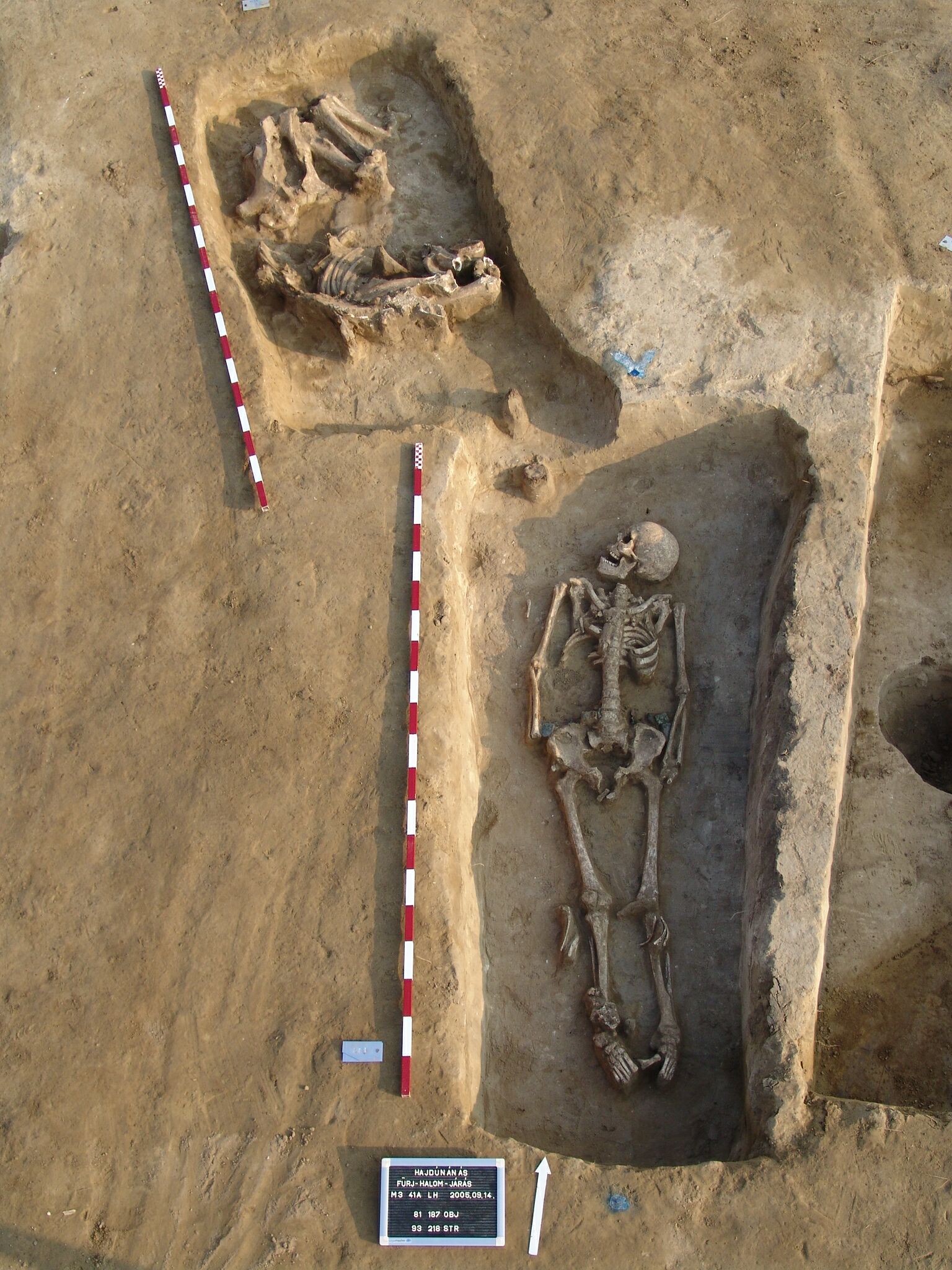Led by researchers from the Eötvös Loránd University and the Max Planck Institute for Evolutionary Anthropology in Leipzig, the study that reveals the patterns of kinship organization in Avar society (6th-9th century AD) was published in the scientific journal Nature.
The researchers examined the burials of four Hungarian Great Plain sites using over 400 genetic samples. Unlike previous studies in archaeogenetics, they made efforts to sample extensively (covering all excavated graves, i.e., individuals from the period) at each site. Thanks to this method, it was possible to investigate both the kinship networks within communities and those among different communities. The study was carried out in broad international collaboration involving geneticists, archaeologists, anthropologists, isotope researchers, bioinformaticians, cultural anthropologists and historians within the framework of the HistoGenes ERC Synergy Grant (No. 856453) project funded by the European Research Council.
 The excavations of the Eötvös Loránd University at the Avar-period (6th-9th century AD) cemetery of Rákóczifalva, Hungary in 2006, Institute of Archaeological Sciences, Eötvös Loránd University, .
The excavations of the Eötvös Loránd University at the Avar-period (6th-9th century AD) cemetery of Rákóczifalva, Hungary in 2006, Institute of Archaeological Sciences, Eötvös Loránd University, .
The eastern groups of the Avar Khaganate appeared in the Carpathian Basin in 568 AD. According to written and genetic sources (Cell), their leaders fled from the steppes of Inner Asia, specifically from the territory of present-day Mongolia, during the rise of the Turkic Empire, and were joined by other Eurasian nomadic groups during their migration. In the Carpathian Basin, they settled on the remnants of the Gepid and Lombard Kingdom populations, which that had defined the previous era. After several decades of intense warfare with the Byzantine Empire, they gradually settled and adopted a sedentary lifestyle based on internal resources. They controlled the region until the beginning of the 9th century, when Charlemagne's campaigns ended their power.
The population of the cemeteries published in Nature belonged to the eastern, steppe-originating groups of the Avar Khaganate (Rákóczifalva, Kunpeszér, Kunszállás, Hajdúnánás). Genetic and archaeological investigations have shown that the communities in the Danube-Tisza Interfluve may came from Inner Asia, while those in the Trans-Tisza region might have originated from the eastern European and Black Sea steppe regions. Although their origins were diverse, they lived in similar kinship structures, consistent with historical sources and ethnological studies of Eurasian steppe peoples. Accordingly, detailed data on Avar society were not available from any other source until now, making this entirely the result of new archaeogenetic research.
Genetic studies identified numerous first-, second-, and third-degree kinship relationships among the buried individuals, enabling the reconstruction of extensive family trees. The populations in the four cemeteries were organized based on similar principles: a strict patrilineal system emerged, in which patrilocality and female exogamy were the norms, meaning men remained within the community after marriage while women always came from elsewhere. Communities were organized around a main paternal line of descent. Communities were organized around a primary paternal lineage. In many cases, individuals had children with multiple partners, possibly due to remarriage after the death of a spouse or polygyny.
 Double burial with a male skeleton and a horse from Hajdúnánás, Hungary (7th century AD). This male individual was the founder of the cemetery/community. Institute of Archaeological Sciences, Eötvös Loránd University,
Double burial with a male skeleton and a horse from Hajdúnánás, Hungary (7th century AD). This male individual was the founder of the cemetery/community. Institute of Archaeological Sciences, Eötvös Loránd University,
Thanks to the comprehensive sampling, population turnover could be demonstrated in the community of Rákóczifalva. In terms of genetic origin, the earlier and later populations were fundamentally similar, with only the paternal lineage differing. Neither archaeological data nor isotopic (strontium) analyses suggested that the new population came from outside the Carpathian Basin. Likely, internal power shifts within the Avar Khaganate led to the appearance of new rulers along the Tisza River, and the transformation of local population dynamics in the second half of the 7th century.
An important lesson from the revealed social organization is that despite significant changes in lifestyle and economic systems in the Carpathian Basin, the eastern-origin communities retained their steppe-like social structures.
The leaders of the HistoGenes 856453 ERC-2019-SyG project are Walter Pohl (Austrian Academy of Sciences, Vienna), Patrick J. Geary (Institute for Advanced Study, Princeton), Johannes Krause (Max Planck Institute for Evolutionary Anthropology, Leipzig), and Tivadar Vida (Eötvös Loránd University, Budapest).
The first authors of the study are Guido Alberto Gnecchi-Ruscone (MPI EVA) and Zsófia Rácz (ELTE), with Zuzana Hofmanová (MPI EVA) as the lead researcher. Additional archaeologists and anthropologists from the Institute of Archaeology at Faculty of Humanities and the Department of Anthropology at Faculty of Science, Eötvös Loránd University include Levente Samu, Tamás Szeniczey, Norbert Faragó, Bence Gulyás, István Koncz, Olga Spekker, and Tamás Hajdu.
The anthropological remains are curated at the Hungarian Natural History Museum and the Department of Anthropology at the University of Szeged.
 Sampling at the Laboratory of the Institute of Archaeogenomics, HUN-REN RCH.
Sampling at the Laboratory of the Institute of Archaeogenomics, HUN-REN RCH.
The preparation of genetic samples was carried out by the employees of the HUN-REN BTK Archaeogenomic Institute: Viktória Bódis, Sára Gábriel, Botond Heltai, Koppány Kerestély, and Daniella Pokker, under the supervision of Anna Szécsényi-Nagy and Balázs Gusztáv Mende.
The research is supported by the European Research Council under the European Union's „Horizon 2020” research and innovation framework program (Grant Agreement No. 856453 ERC-2019-SyG).


